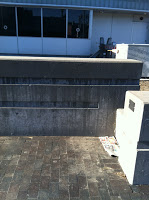Bollards—those vertical posts used to keep cars off of bike trails or separate lanes of traffic—are also used to protect sensitive buildings from vehicular incursions. Many government buildings—and most of the city of Washington, D.C.—are surrounded by steel or concrete posts. In most cases, these are architectural afterthoughts, and in many cases they are ugly as sin. While they seem to crop up everywhere, their use, especially after incidents like the 1995 Oklahoma City bombing, is probably justified in some situations. They are relatively inexpensive, don’t impede pedestrian flow, and are quite effective (i.e. not just security theater).
Left: Ugly-as-sin bollards at the Tip O’Neill Building near North Station (probably added after construction). Right: Boring bollards at the newly-built Moakley Courthouse on Fan Pier.
And they don’t have to be ugly as sin.
Take, for example, the Boston Federal Reserve bank. Considering it is one of 12 banks in the country charged with distributing the nation’s cash supply, you probably don’t want people to be able to ram a car in to it. The modernist building is striking—it’s by far the tallest Federal Reserve Bank branch in the country and one of the tallest buildings in the city of Boston—so it has quite a bit of symbolic value. For a variety of reasons, you don’t want cars driving in willy-nilly. (If you do drive in, you go through a heated inspection building where they inspect your vehicle, including peering underneath with mirrors on sticks.)
Around the time of the Big Dig (check it out on HistoricAerials, or this picture from the installation firm) the plaza around the building was rebuilt, and instead of a bunch of concrete or aluminum-and-steel bollards, the landscape architects got creative. There are no fewer than 15 distinct types of bollard (!)—or other fencing with a similar function—combining different materials and serving multiple purposes. Many of these are cleverly camouflaged in to the landscape. You still get the idea that they don’t want you trying to ram through the doors in a car, but it’s not as ugly or overbearing as most such security.
I noticed this (yet again) coming back from a talk by Julie Campoli, who has cataloged housing types and walkability beautifully in presentations and books, and decided to do something similar with the Fed bollards. Here is a compendium, with descriptive names I made up.


















I'm local to Albany NY and have never seen the Tip O'Neil Building. I'm a professional artist so I could use a lot of artistic terminology and rules of balance, composition, harmony, etc. to detail why I like those bollards, but they just look nice to me. They are big and important and solid and that's part of the psychology of government administration buildings. But they are also human in scale. They don't block the view unless you're a tyke who would almost certainly be amused by them anyway. I'd like to sit on one and have a bite.
Agree to disagree, I guess. I find that they don't fit with the streetscape down low (really no bollards block views; they're all a few feet high), they are prone to getting moved about, the texture has nothing to do with the area nearby, or really the city in general, and they block a lot of movement on the sidewalk in an otherwise high-pedestrian area.